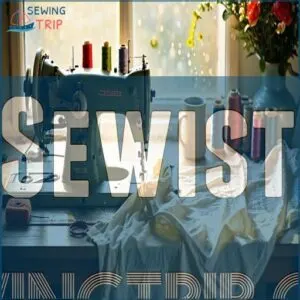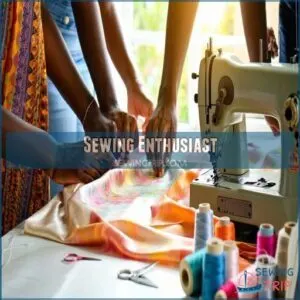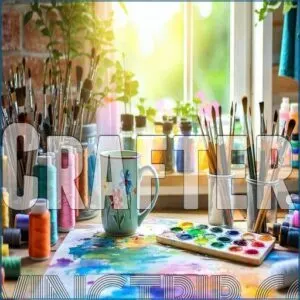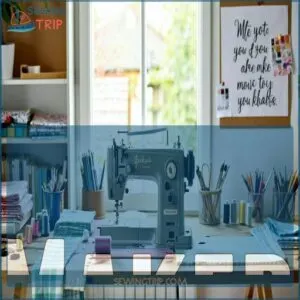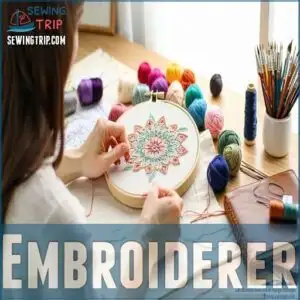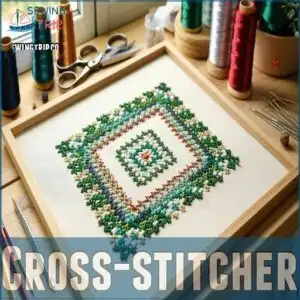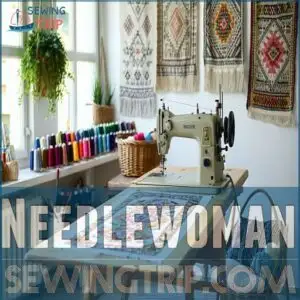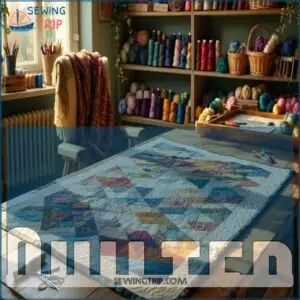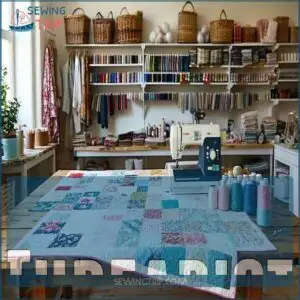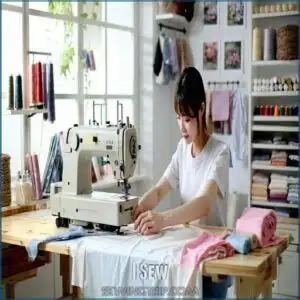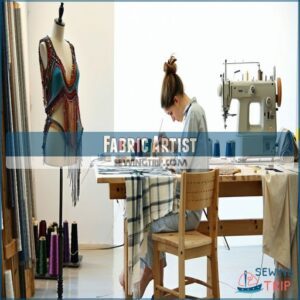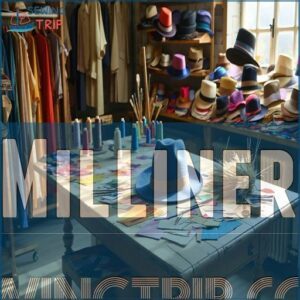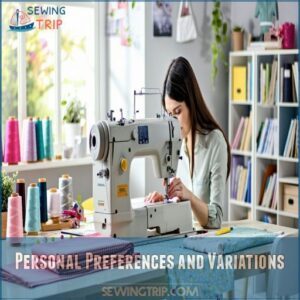This site is supported by our readers. We may earn a commission, at no cost to you, if you purchase through links.
 From traditional to modern, a rich tapestry of terms exists for someone who sews. "Sewer" and "seamstress" are classic choices.
From traditional to modern, a rich tapestry of terms exists for someone who sews. "Sewer" and "seamstress" are classic choices.
Today’s fabric artists often prefer "sewist"—a fresh blend of sewer and artist, adding creative flair.
Other options reflect specific passions: "sewologist" for precision or "maker" for hands-on creation.
The sewing community’s vocabulary has evolved beyond gender-specific terms, embracing inclusive options like "sewing enthusiast" and "threadist." Each term carries its own historical significance, reflecting the craft’s deep roots in medieval traditions and modern innovations.
Table Of Contents
Key Takeaways
- You can call yourself a sewist, sewer, or embrace specific titles like seamstress, tailor, or threadist depending on your sewing focus and style.
- Today’s sewing terms are gender-neutral and inclusive, allowing you to express both your technical skills and creative flair.
- Whether you’re a hobbyist or professional, modern sewing mixes artistry and craft, from garment making to quilting and embroidery.
- Your choice of sewing identity reflects your passion and expertise, blending traditional craftsmanship with modern creativity.
Traditional Terms for Someone Who Sews
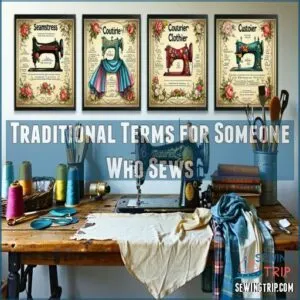
Traditional sewing terms range from the classic "seamstress" and "tailor" to the more specialized "couturier" and "custom clothier."
While you might chuckle at being called a "sewer" (yes, it’s the same spelling as that underground pipe), it’s actually the original term recognized by the Oxford English Dictionary for anyone who creates with needle and thread.
Sewer
Despite the waste-pipe confusion, "sewer" remains the historically correct term for someone who sews. This gender-neutral alternative has rich occupational connotations dating back centuries.
Modern relevance shows through its continued use:
- Strong historical usage traced to medieval Latin roots
- Embraced by traditional crafting communities worldwide
- Often hyphenated as "sew-er" to avoid confusion
- Precursor to contemporary terms like sewist
Whether you’re starting or skilled, you’re officially a sewer – just own it!
Seamstress
When you think about traditional Sewing Careers, "seamstress" stands out as a time-honored title in Female Tailoring.
While historically exclusive to women professionals, today’s seamstress role encompasses diverse Textile Skills and Garment Construction expertise.
| Aspect | Modern Evolution |
|---|---|
| Role | Professional garment maker |
| Skills | Pattern drafting, alterations |
| Tools | Machine and hand sewing |
| Training | Formal or self-taught |
| Recognition | Fashion Design certified |
Seamster
While seamstresses dominated the sewing world, male sewing roles carved their own niche through the title ‘seamster‘. This historic sewing term originated from medieval tailoring traditions, where craftsmen learned their trade through sewing apprentices.
Here’s what made seamsters stand out:
- They specialized in structured garments like coats and uniforms
- Many worked in specialized guilds and workshops
- They often trained younger apprentices in the craft
Today, while some prefer gender neutral titles like sewist or sewer, the term seamster preserves a rich heritage of men’s contributions to the craft.
Tailor
A tailor’s skilled hands turn fabric into perfectly fitted garments through expert clothing alteration and construction.
You’ll find them crafting everything from sleek suits to precise hemlines, using time-tested sewing techniques to transform off-the-rack pieces into custom masterpieces.
Unlike a basic sewist or seamstress, tailors specialize in structured garments and possess deep knowledge of textile science and pattern modification.
Couturier
A couturier stands at fashion’s pinnacle, crafting haute couture masterpieces that blend artistry with textile science. You’ll join an elite circle of fashion design innovators who create custom clothing that defines luxury.
- Master intricate hand-sewing techniques passed down through generations
- Transform premium fabrics into wearable art pieces
- Create original patterns that push design boundaries
- Develop signature construction methods
- Build relationships with exclusive clientele
When you’re a couturier, every stitch tells a story of excellence.
Dressmaker
A dressmaker specializes in creating custom garments from scratch, taking your design dreams from paper to reality. Unlike a seamstress who focuses on alterations, you’ll master both fashion design and garment construction, breathing life into unique pieces through expert pattern cutting and textile selection.
Understanding the sewing profession is important for those who aspire to become professional dressmakers or seamstresses.
| Skill Area | What You’ll Learn |
|---|---|
| Design | Pattern drafting, sketching |
| Construction | Seam finishes, fitting |
| Materials | Fabric types, notions |
| Tools | Machine techniques, hand sewing |
| Business | Client consultation, pricing |
Modern dressmakers blend traditional craftsmanship with digital tools like CAD software, making it easier to create precise sewing patterns while maintaining that personal touch your clients love.
Custom Clothier
A custom clothier takes personal styling to new heights, crafting custom-made fashion pieces that fit like a dream. Unlike mass-produced clothing, you’ll create garments that tell unique stories through fabric and form.
As a sewist in this specialized field, you’ll transform from a basic sewer into an artist of custom suits and distinctive designs.
- Master the art of precise measurements and fitting techniques
- Develop relationships with premium fabric suppliers
- Create detailed design sketches for client approval
- Build a portfolio of custom garment designs
- Learn fashion consulting to guide clients’ style choices
Your expertise in garment design will help clients feel confident in clothes made just for them.
Garment Maker
A garment maker brings fashion design to life through expert sewing techniques and careful attention to clothing patterns.
You’ll craft everything from casual wear to formal attire, mastering textile science and garment construction along the way.
Unlike a traditional seamstress or tailor who might focus on alterations, you’re the creative force behind original designs, think of yourself as a craftsperson who transforms fabric into wearable art through precise measurements and skilled stitching.
Stitcher
A skilled stitcher goes beyond just making garments – you’re a master of thread work who brings fabric to life through precise needle skills. Your expertise shows in every carefully placed stitch, whether you’re working on intricate embroidery art or finishing a couture gown.
Like a conductor directing an orchestra, you orchestrate different sewing tools to create harmony in fabric craft. You might hear terms like sewer or sewist, but stitcher captures the artistry in your work. It’s more than just a sewing person meaning – it’s about crafting beauty one stitch at a time.
Here’s what makes you stand out as a stitcher:
- Your ability to create invisible seams that look like they’re part of the fabric’s design
- Your knack for choosing the perfect stitch type for each project
- Your steady hand with decorative stitching that turns plain fabric into art
- Your eye for detail that spots even the tiniest misplaced thread
Modern and Gender-Neutral Terms
You’ll love how today’s sewing community has moved beyond outdated gender-specific terms like seamstress or tailor, embracing modern alternatives that celebrate everyone’s creativity.
Whether you’re calling yourself a sewist, maker, or simply saying "I sew," you’re part of an inclusive movement that’s reshaping the craft for a new generation.
Sewist
The term "sewist" perfectly blends your identity as both a sewer and artist, offering a fresh take on Sewing Culture. It’s a modern way to proudly declare "I’m someone who sews."
You’ll often spot this trendy title in creative stitching blogs and social media, where it’s gained popularity since the 2000s. While it’s not in dictionaries yet, this gender-neutral term celebrates your Fabric Creation skills and Needle Art passion.
Many sewing enthusiasts also explore the sewing titles to best describe their professional or hobbyist identity.
Sewologist
If you’re passionate about sewing expertise and love diving deep into fabric knowledge, you might call yourself a sewologist. This playful spin on traditional sewing terms suggests someone who studies the craft with scientific precision.
- Combines advanced sewing techniques with methodical analysis
- Masters both practical skills and theoretical understanding
- Explores historical perspectives and modern innovations in sewing
Think of it as being a professor of thread and needle – it’s perfect for those who approach their craft with scholarly dedication.
Sewing Enthusiast
Among creative minds and nimble fingers, sewing enthusiasts bring their passion projects to life with every stitch. Whether you’re crafting cozy quilts or stylish garments, this gender-neutral term celebrates your dedication to the craft.
| Activity | Benefit | Community Impact |
|---|---|---|
| Skill Development | Personal Growth | Inspires Others |
| Sharing Creations | Builds Confidence | Creates Connections |
| Sewing Challenges | Masters Techniques | Supports Learning |
Your sewing hobby goes beyond just making things—it’s about joining a vibrant community of fellow enthusiasts who share your passion. Through online forums and local meetups, you’ll find endless inspiration and support for your creative journey.
Crafter
While sewing enthusiasts focus solely on needlework, crafters embrace a broader creative spectrum.
You’ll find yourself wielding sewing kits alongside other craft tools, turning fabric scraps into DIY projects and handmade gifts.
As a crafter, you’re part of a versatile community that doesn’t limit itself to just one medium.
Your creative toolkit might include everything from needles to paint brushes, making the term perfect for those who love exploring multiple artistic avenues.
Maker
A maker’s journey starts with a spark of creativity and grows through hands-on Craft Skills. You’re not just someone who sews – you’re a creator who brings ideas to life through careful Fabric Choice and precise Sewing Tools. Your maker mindset drives you to explore new techniques and push boundaries.
Here’s what sets you apart in the Creative Process:
- You blend traditional sewist methods with modern innovations, creating unique pieces that tell stories
- You’re constantly learning, whether it’s mastering new stitches or experimenting with fabric combinations
- You view challenges as opportunities, turning mistakes into design features
- You connect with other makers, sharing tips and inspiration in the community
As a maker, you’re part of a movement that values handcrafted quality over mass production. Each project showcases your evolution from stitcher to artist.
Embroiderer
Got your hands full with maker projects? Let’s add another creative skill to your arsenal – embroidery. As an embroiderer, you’ll transform plain fabrics into stunning artwork using stitch patterns and vibrant thread colors.
Your journey starts with picking the right needle types and fabric choices for your embroidery designs. You might start with simple running stitches, then level up to French knots and satin stitches. Whether you’re a seasoned needleworker or a curious sewist, embroidery lets you paint with thread.
Ready to join the ranks of modern needlewomen? Grab a hoop, pick your threads, and watch as your needle dances across the fabric, creating something uniquely yours.
Cross-stitcher
Like embroiderers, cross-stitchers create stunning textile art, but with a unique twist: they work exclusively in X-shaped stitches on counted fabric. You’ll find yourself mastering stitch patterns from simple to complex, turning blank fabric into vibrant designs one careful X at a time.
- Feel the satisfaction of completing your first sampler piece
- Experience the thrill of selecting perfect thread colors for your design
- Join a welcoming community that shares your passion for counted thread work
- Watch your skills grow as you tackle increasingly intricate patterns
Cross-stitchers blend traditional techniques with modern designs, making this time-honored craft fresh and exciting for today’s sewists and needleworkers.
Needlewoman
While cross-stitching focuses on specific patterns, needlework opens up a whole new world of creativity.
As a needlewoman, you’ll master various sewing skills that blend traditional needle art with modern fabric design. You’re not just someone who sews – you’re a craftsperson who brings thread crafts to life with every stitch.
Whether you prefer the title needlewoman or needleworker, your expertise spans from intricate embroidery to yarn weaving. Many sewists and seamstresses started their journey in the gentle art of needlework, learning the basics before branching out.
Remember, being a needlewoman isn’t just about the craft – it’s about carrying forward a rich tradition of textile artistry.
Quilter
In today’s vibrant sewing community, quilters blend traditional craftsmanship with modern artistry.
You’ll find these fabric artists transforming simple squares into stunning masterpieces using essential quilting techniques:
- Select quality cotton fabrics for durability
- Cut precise patchwork designs
- Master basic quilt patterns
- Use proper sewing tools for assembly
- Perfect your binding technique
To get started, many quilters rely on quilt making kits that include pre-cut fabrics and patterns.
From cozy bed coverings to intricate wall hangings, quilting offers endless creative possibilities, and each piece tells a unique story through carefully chosen colors and patterns.
Threadist
Creativity flows through the hands of every threadist, a modern title that perfectly captures the artistry of working with fabric and yarn. This fresh term has gained traction in the Sewing Culture, offering a playful, gender-neutral alternative to traditional labels like sewer or sewist. It celebrates the joy of creating with thread, whether you’re stitching garments or crafting textile art.
Understanding the sewing definition is essential to appreciating the craft.
As Textile Design evolves, you’ll find threadists exploring everything from Fiber Crafts to Fabric Trends, bringing their unique vision to the craft.
I Sew
Many sewers simply say "I sew" to describe their sewing journey, embracing the straightforward nature of their craft.
When someone asks what you’re called as a person who sews, this direct approach cuts through the confusion of formal titles.
It’s a natural way to share your favorite projects and sewing challenges without getting tangled in terminology. Plus, it keeps the focus on your fabric choices and creative process.
Specialized Sewing Terms
Specialized sewing terms like fabric artist, textile artist, and milliner add a creative twist to your sewing identity.
These unique titles showcase your specific skills and talents, whether you’re crafting wearable art or designing stunning hats.
Fabric Artist
Innovative fabric artists transform ordinary textiles into extraordinary art pieces through creative sewing and fiber expression. You’ll explore unique textile manipulation techniques, turning cloth into a powerful art medium for storytelling.
Whether you’re crafting wearable art or experimental wall hangings, your role as a fabric artist lets you push creative boundaries.
Understanding sewing basics is essential to bring your artistic vision to life. It’s more than just stitching—it’s about bringing your artistic vision to life through needle and thread.
Textile Artist
Textile artists weave magic through fiber manipulation, transforming ordinary materials into extraordinary art. Your journey into textile design opens up endless possibilities for creative expression.
- Master surface embellishment techniques like appliqué and embroidery
- Experiment with dyeing and printing on various fabrics
- Explore mixed media by combining different textile materials
- Create unique textures through layering and stitching
As a needleworker in this specialized field, you’ll blend traditional craft with contemporary artistry, making each piece a personal statement.
Milliner
From Victorian times to today’s runways, milliners have shaped the art of hat making with precision and flair. You’ll join a rich millinery history of crafting everything from classic fedoras to avant-garde headpieces.
Here’s what modern millinery involves: Understanding milliner hats is essential to creating unique pieces.
| Skill Level | Techniques | Materials |
|---|---|---|
| Beginner | Blocking | Felt |
| Intermediate | Stitching | Straw |
| Advanced | Steaming | Silk |
| Expert | Draping | Leather |
| Master | Embellishing | Wire |
Whether you’re crafting a simple sunhat or dreaming up runway-worthy designs, millinery combines traditional sewing skills with sculptural artistry.
Personal Preferences and Variations
You’ll find that picking your sewing title is as personal as choosing your favorite fabric, and there’s no wrong answer whether you prefer "sewist," "sewer," or any other term.
If you’re worried about the awkward spelling of "sewer," you can join the growing crowd of creative stitchers who’ve embraced newer terms like "sewist" or simply say "I sew.
Personal Preference Varies
Explore your sewing identity like trying on a perfectly fitted garment – it should feel natural and uniquely you. Your choice of title, whether sewist, sewing artist, or fabric enthusiast, reflects your personal style and creative expression.
Here’s what shapes your sewing persona:
- Your specialty (quilting, garment making, embroidery)
- Your skill level (beginner, intermediate, expert)
- Your creative approach (traditional, modern, experimental)
- Your professional goals (hobbyist, business owner, artist)
Confusion With The Term Sewer
In the context of naming conventions in the sewing world, the term "sewer" often hits a semantic snag.
You’ll quickly notice it’s identical to that underground water system, causing some awkward moments in written communication.
While traditionally accurate for describing someone who sews, many prefer alternatives like seamstress, tailor, or couturier to avoid this language barrier in their sewing identity.
Embracing Language Evolution: Sewist
Today’s sewing culture embraces’sewist’ as a fresh alternative to traditional terms like sewer or seamstress. This language shift reflects your creative expression and sewing identity in a gender-neutral way.
Here’s why it’s catching on:
- Combines’sew’ and ‘artist’ to honor both craft and creativity
- Avoids confusion with the plumbing term’sewer’
- Resonates with modern fabric trends and DIY culture
- Welcomes everyone into the sewing community, regardless of skill level
You’ll find this term increasingly popular in online communities and sewing magazines.
Choosing Your Sewing Title
You’ll find that picking your sewing title isn’t just about following tradition – it’s about choosing a term that matches your unique skills and makes you feel proud of your craft.
Whether you’re just starting to thread your first needle or you’re crafting couture pieces, your title should reflect both your expertise and the joy you bring to your sewing projects.
Considering Your Skills and Specializations
Behind every stitch lies a unique set of sewing skills that shape your identity in the craft. Whether you’re a sewing hobbyist experimenting with fabric choices or a seasoned professional mastering complex sewing techniques, your title should reflect your skill level and creative expression.
You’ll find your perfect title by matching your expertise with specialized areas like garment construction, pattern making, or quilting. From altering basic patterns to crafting intricate couture pieces, your chosen designation helps others understand your unique capabilities in the sewing profession.
Exploring sewing as a career can help you discover various paths and opportunities within the industry.
Reflecting Your Passion and Expertise
Your sewing identity blooms from mixing passion projects with growing expertise. Whether you’re a weekend sewing enthusiast or diving into the sewing profession, let your unique style shine through every stitch.
Focus on skill development that excites you — maybe it’s precise tailoring or wild creative expression through fabric art. Build your personal branding naturally by showcasing expertise in areas you love, whether that’s quilting, garment construction, or textile art.
Share your journey through community engagement, connecting with fellow makers who get your creative vision. Your dedication to craft speaks volumes about who you are in the sewing world.
Helpful Sewing Tips
Whether you’re wrestling with stubborn fabric creases or trying to keep track of your machine needles, you’ll find these practical sewing tips incredibly useful.
Let’s explore some clever tricks that’ll make your sewing adventures smoother and more enjoyable, from proper pressing techniques to smart organization hacks that even seasoned sewists wish they’d known sooner.
Removing Creases From Fabric
Master these ironing techniques to keep your fabric smooth: hit stubborn creases with a burst of steam, or spritz lightly with water before pressing. For delicate fabrics, try steaming methods from a distance.
Remember, pressing tools are your best friends – they’ll help you achieve that professional, crisp finish every time.
Prevent future headaches by storing your materials rolled up instead of folded.
Down in the trenches of sewing, wrinkles can throw off your whole project. To achieve perfection, understanding sewing machine basics is essential for a smooth sewing experience.
Tracking Sewing Machine Needles
Keeping track of sewing machine needles is like managing a tiny toolkit – messy needles mean messy projects. Create a needle inventory system that’ll save you headaches and fabric snags down the line.
- Store different needle types in labeled compartments, tracking usage dates and fabric types in a small notebook
- Establish a disposal system for dull or bent needles using a dedicated sharps container
- Set up a monthly reminder to check your needle organization methods and replace worn ones
This simple organization keeps your sewing tools ready for action whenever inspiration strikes.
Using Pressing Tools
Through proper pressing techniques, you’ll transform wrinkled fabric into professional-looking garments. Your trusty steam iron, paired with specialized tools, makes all the difference in achieving those crisp seams.
Utilizing the right Pressing Tools can greatly enhance your sewing experience.
Always match heat settings to your fabric type for perfect results.
| Tool | Purpose | Best For |
|---|---|---|
| Tailor’s Ham | Curved Pressing | Darts, Sleeves |
| Seam Roll | Narrow Areas | Pant Seams |
| Point Presser | Sharp Angles | Collars, Cuffs |
Etymology and Clarification
You’ll find it fascinating that the word "sewer" comes from Latin and first appeared in medieval poetry, long before it got mixed up with the plumbing kind we’re familiar with today.
If you’re wondering why modern crafters prefer "sewist," it’s because this newer term cleverly combines "sew" with "artist," giving your hobby the creative respect it deserves.
History of The Term Sewer
Now that you’ve got those handy sewing tips in your toolkit, let’s explore where the term "sewer" came from.
The word has quite a story behind it—first appearing in Samuel Johnson’s English dictionary back in 1755.
While modern terms like sewist and seamstress have gained popularity, "sewer" remains deeply rooted in sewing history.
Some writers now use "sew-er" to avoid any confusion with drainage systems. The sewing community has also adopted the term sewist to promote a more gender-neutral description of sewing professionals.
Rooted in Latin and Medieval Poetry
Sewing’s Latin origins run deeper than you might think, with the term "sewer" first appearing in medieval poetry. Back then, crafting with needle and thread wasn’t just practical – it was an art form worthy of poetic praise.
Understanding the sewing definition is important to appreciating its historical and cultural significance.
You’ll find this sewing heritage woven through ancient roots, from seamstresses crafting royal garments to tailors perfecting their trade.
While modern terms like sewist have evolved to be more inclusive, traditional titles like couturier still carry that medieval influence, reminding us how this craft has shaped culture for centuries.
Frequently Asked Questions (FAQs)
What is a sewing person called?
A stitch in time saves nine!
Sewist or sewer are terms for hobbyists who love stitching.
Professionals are known as seamstress, tailor, or couturier, depending on their specialty.
What defines a sewer person?
A sewer person is someone who creates or repairs items using needle and thread.
They’re often called sewists or seamstresses today.
They combine artistic skills with technical expertise in fabric manipulation.
What is the difference between a seamstress and a sewist?
A seamstress is your traditional professional garment maker for hire.
A sewist is the modern hybrid – part artist, part sewer – who might dabble in anything from quilting to costume design.
What is a sew job called?
Professional sewing roles include seamstress, tailor, dressmaker, and couturier.
You’ll find stitchers in factories, while custom clothiers work independently.
The modern term sewist combines sewing with artistry for hobbyists and professionals alike.
How much training is needed to become professional?
Think of sewing training like planting seeds—you need the right skills to grow.
Formal programs take 6 months to 2 years, but hands-on practice, workshops, and apprenticeships help you refine your craft and specialize.
What certification programs exist for sewing professionals?
You’ve got plenty of choices: get certified through programs like the Association of Sewing and Design Professionals, Custom Tailors & Designers Association, or online platforms like Craftsy and Sew It Academy for excellent sewing credentials.
Can someone make a living through sewing?
Turning stitches into riches is totally possible.
You can sew custom clothes, handle alterations, or create crafts to sell online.
With skill, creativity, and hustle, sewing can absolutely pay the bills—and then some!
Which countries have the highest demand for sewers?
Countries like the United States, Canada, the United Kingdom, and Germany have strong demand for sewers, especially in fashion, upholstery, and custom tailoring.
Emerging markets like India and Bangladesh also thrive due to textile production.
Do hand sewers earn differently from machine operators?
Funny how needle and thread don’t pay equally—hand sewers often earn less since their work is slower and more niche,
while machine operators, with faster production rates, typically rack up higher wages in industrial settings.
Conclusion
Did you know over 60% of people who sew identify as hobbyists rather than professionals?
Whether you call yourself a sewist, a sewer, or a fabric artist, the creative options are endless.
Finding the right term isn’t just about tradition—it’s about embracing what feels authentic to you.
So, explore titles like "threadist" or stick with classics like "tailor." Whatever you choose, you’re part of a vibrant sewing community redefining what a “sewing person” truly means.

